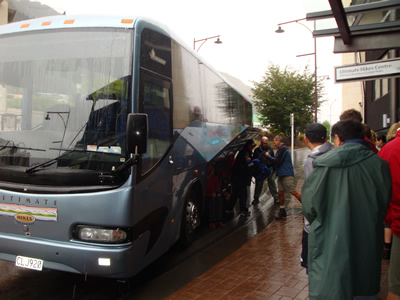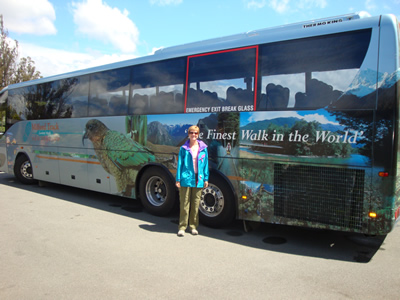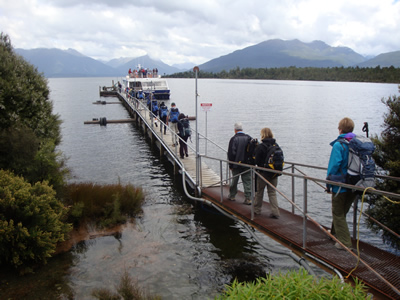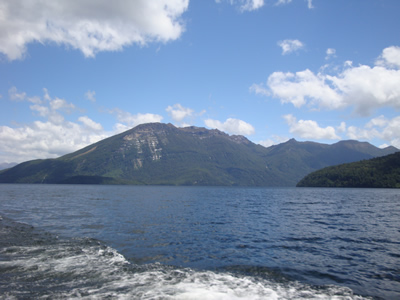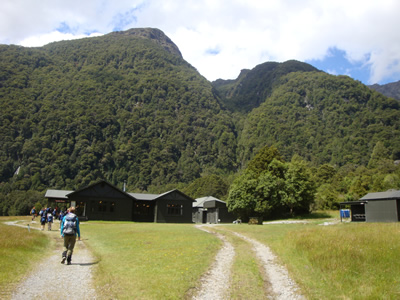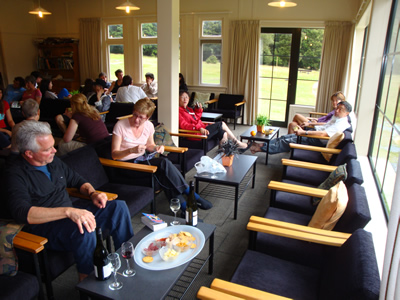Milford Track
After our pleasant day in Dunedin we were rested up, almost adjusted to the time change, and ready to head for the mountains. We spent a morning driving to Queenstown, the center for international tourism and main gateway to the mountains of the South Island. We had been there last year and had done excellent hikes to the summits of Queenstown Hill and Ben Lomond. Our drive there was through some familiar territory as well, going through the towns of Cromwell and Arrowtown which we had visited last year. The weather didn't seem to be too bad so we were surprised to learn that only an hour and a half after we drove through Cromwell a tornado tore the roof off of a building. When they say the weather in New Zealand can change quickly, they aren't kidding. But we made it through, got checked into our hotel, and turned in our rental car. We wouldn't need it for where we were going next, the Milford Track.
For thirty years, ever since I had been combining hiking and climbing mountains with travel around the world, I have wanted to do the Milford Track. It is the most famous hike in New Zealand, one of the "great walks". Browse almost any book on great hikes of the world and you will find the Milford listed alongside trips to the Himalayas, the Alps and the Andes. It is often referred to as "The Finest Walk In The World" from the title of a London Spectator article on the Milford Track published in 1908. I was extremely envious when Shannon got a chance to hike the Milford with a group from the Singapore American School back in 2007. I had almost stowed away in her baggage.
But doing the Milford Track is not a trivial undertaking. First of course you have to get to New Zealand. That's a long way to travel from North America and even quite a way from Singapore. But Sandy and I were planning to go to New Zealand, so we were going to be "in the neighborhood". Even then it is in Fiordland, a remote area in the far southwest of the island penetrated by only a very few long, windy roads. And both ends of the Milford Track are not even accessible by car but only by boat.
The next consideration is that it is a multiday hike. The Milford is 33.5 miles one way so most people take three long days to hike the main section of the trail. And since everyone hikes it one way (controlled by NZ DOC - Department Of Conservation) they need an extra day at each end to travel to and from the ends of the hike from a central location like Queenstown or Te Anau. The DOC strictly regulates travel on the Milford. Camping is not allowed and would not be practical anyway given the weather in the area. More on that later. There are huts along the track and hikers must stay in those huts. The number of spaces is limited so arrangements have to be made long in advance.
Sandy is a hiker but not a backpacker so the nature of the accommodation was a major factor for her. It turns out that there are actually two sets of huts along the Milford. One set is reserved for "independent walkers". You hike on your own and carry all your own clothes and food. You sleep dormitory style at the huts and use common bathroom and cooking facilities there. The DOC charges a moderate fee for the huts. Because of the limited space in the huts only forty independent walkers are allowed to start the track per day. They are usually booked a year or more in advance. That wasn't relevant for us though as Sandy wasn't interested in doing the hike in this style. Seemed too much like camping to her.
The other huts are for "guided walkers". We certainly didn't need a guide to hike the Milford Track, but the accommodation for guided walkers is much more luxurious. You sleep at the huts but it can be either dormitory style or in a private room with its own bath. You don't need to carry food as all meals are prepared for you. You can even buy soda, beer or wine at the huts. It is available through Ultimate Hikes and is quite expensive. There are fifty slots for guided walkers per day but the cost keeps the demand down somewhat so it is possible to get a spot without reserving years in advance. We had picked our dates and made our reservations back in September and were set to go.
Which brings me to the last important factor in hiking the Milford Track - weather. The lush rainforest, roaring rivers, abundant waterfalls and glacier mantled peaks make for fantastic scenery along the walk. But what creates that scenery is rainfall. Lots of it. Milford Sound, where hikers end their walk of the Track, has an average annual rainfall of about 6800 millimeters. (That's 268 inches in case you are challenged by third grade math.) By comparison Boise Idaho gets eleven inches of rain per year. Wisconsin gets about sixty inches. On average there are 182 days of rain per year in Milford Sound. So it rains often and it rains a lot. Since it takes five days to hike the Milford Track you have to be prepared for rain. In fact you have to be prepared for a lot of it. As much as ten inches of rain have been recorded in a twenty four hour period. Plus in any mountain region it can also be cold and windy even in the middle of summer. And if the weather is bad you have to go for it. Since dates are reserved months or even years ahead of time, there is no checking the forecast before heading out and deciding whether or not to go. And once on the trail you have to move every day. No looking out and deciding the weather is lousy and staying around the hut. There is another hiker with a reservation for the bed you slept in the previous night heading down the trail. It's get up and get out. Wham, bam, thank you ma'am. We had definitely paid our money and were taking our chances.
We arrived in Queenstown the afternoon before our hike started. I had been watching the weather in New Zealand for the week before we left Singapore and it hadn't been good. The weather hadn't been too bad in Dunedin but it hadn't been great either. And that is on the dry side of the mountains. Fiordland National Park has a desk in one of the large mountaineering stores that is for hikers doing the Milford, Routebourn or Hollyford Tracks (the other two famous tracks in the area). They have very good weather information there so it was the first place that we went. I couldn't believe it. Rain that day, the next morning, and then a clearing trend. The weather looked good. Given the temperamental nature of the weather in Fiordland though a good forecast might be the worst possible thing.
We attended a mandatory briefing at the Ultimate Hikes office. We had a dinner at our favorite funky pizza place in Queenstown - The Cow. When our waitress recognized the Milwaukee Brewer emblem on my tshirt it turned out that she was originally from Wisconsin. She even (correctly) pronounced it Muh-wau-kee. After dinner we bought a few last minute items. Then we headed for our hotel to get everything for the next five days into our packs. Everything else went into our suitcases and was left with the concierge at the hotel.
The next morning we had everything ready but Sandy was anxiously waiting to hear back from an hp manager on the new job she had applied for. She was hoping that she wouldn't have to stay in suspense for the five days that we would be out of communication. Fifteen minutes before we needed to leave the call came through and she got the offer. Now she was excited and we could start for the mountains. A good omen indeed.
Which was followed immediately by a bad omen. It was raining hard as we walked the two blocks to the Ultimate Hikes office and got onto the bus that would take us to Te Anau. But hey, the forecast said it would rain and then clear up later. This was all according to plan. I wasn't worried at all. Nope. Not me. (Insert whistling in the dark sound here.)
It was a two hour bus ride to Te Anau, the last small tourist center on the road to Milford Sound. There we had our first lunch with the rest of our group, which was 43 hikers and four guides. After that we got back on the bus and drove to the dock at Te Anau Downs. One of the guides briefed us on the boat ride before we left the bus and mentioned that we should "keep a sharp eye out, because if you're lucky you might see some dolphins swimming alongside the boat". Dolphins in a freshwater lake? To see that we would have to be lucky indeed. I think we would be more likely to see the Loch Ness Monster. I think she got the briefing for Lake Te Anau confused with the briefing for Milford Sound (which does indeed have a pod of dolphins). And she was a mountain guide, not a sailing guide.
It was time to grab our packs and hop on the boat for the trip to the end of Lake Te Anau. It's the largest lake on the South Island, almost 40 miles long. It's also extremely deep at 417 meters. What's unusual is that since its altitude is only 210 meters most of the lake bed is below sea level. It's surrounded by mountains and very scenic. By now the rain had stopped, the clouds had partially cleared, and things were looking pretty good.
As we were approaching the dock at the end of the lake, one of the guides mentioned to be very careful as the dock was "quite wet" because of recent rainfall. I asked her on the side how wet it was and she said "underwater". "And how deep underwater would it be?" I asked. "Oh, only knee deep or so". Sandy and I quickly took off our shoes and socks and rolled up our pants legs before we got off. She was right too - the water was just about knee deep. For the dock to be twenty inches underwater on a lake with a surface area of 344 square kilometers, there had to have been a LOT of rain recently. We made it safely to shore though, got our socks and boots on, threw on our packs, and started the Milford Track.
Our stopping place for the first night was Glade House, just a little over a kilometer down the track. We got there in about twenty minutes. Hey, this walking the Milford Track is easy!
